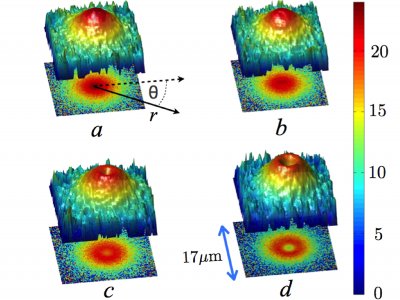Contacts : Alistair Rowe and Daniel Paget.
We have recently developed a polarized microluminescence imaging technique that permits the optical injection of spin polarized electrons over a Gaussian spot of diameter 0.4 microns. The resulting non-uniform spatial density of spin polarized electrons give rise to a diffusion of both charge and spin. When the photo-carriers recombine and emit light, the selection rules dictate that any remaining spin polarized electrons give rise to circularly polarized photons. An analysis of the intensity and polarization of the luminescence yields images of the spatial distribution of the charge and the spin making it possible to determine their respective diffusion lengths. The ratio of these two images is the spin polarization

In the limit where it is possible to treat the electrons classically, the polarization decreases monotonically with distance. This is a simple manifestation of the spin relaxation towards its non-polarized equilibrium state. We recently showed and described a novel effect at high electronic densities where the Pauli principle give rise to an increase in the spin polarization with increasing distance. This surprising observation is linked to the quantum nature of the electrons and can be described in several different ways : a dependence of the diffusion constant on spin, a charge/spin coupling, or indeed the result of the quantum pressure.
The dimension of the electron gas (i.e. 2D as in a quantum well, or 1D as in a quantum wire) should significantly modify this effect, and we are currently offering an internship on this subject. For more information contact Alistair Rowe or Daniel Paget.
It is also worth noting that the microluminescence technique was used to observe other phenomena including ambipolar diffusion and drift, as well as a novel spin/spin coupling.

